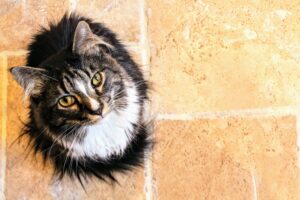The Cymric, a long-haired breed characterized by its lack of a tail, is gaining attention as a popular cat breed worldwide.
Considered a long-haired version of the Manx, the Cymric is even rarer than the Manx itself.
This article introduces the history of the Cymric and what to be aware of if you live with one.
Table of Contents
1. What is a Cymric?
↳ 1-1. What is the history of the Cymric?
↳ 1-2. Are there associations that don't recognize the Cymric?
↳ 1-3. Different names based on tail shape
2. Points to Consider When Living with a Cymric
↳ 2-1. What is the Cymric's personality?
↳ 2-2. Respect their alone time
↳ 2-3. The area where the tail should be is very sensitive
3. Diseases Cymrics Should Be Careful Of
↳ 3-1. Early detection of Manx Syndrome improves quality of life
↳ 3-2. Hairball disease, a fate of long-haired breeds
↳ 3-3. Pay attention to litter box usage
Summary
1. What is a Cymric?

Within the Manx cats from the Isle of Man, there is a low chance of long-haired breeds being born, known as Cymrics.
The Cymric, which lived on the Isle of Man alongside natural Manx cats, has spread worldwide like the Manx.
Let's introduce what kind of cat the Cymric is.
1-1. What is the history of the Cymric?
Also known as the "Long-Hair Manx," the Cymric's history began in the 1920s when American breeders brought them over and popularized them.
It's believed that cats did not suddenly appear on the Isle of Man but were brought by Vikings using the island as a base or by 17th-century traders.
The breed has lived on the Isle of Man for centuries. Its main characteristic is the extremely short or absent tail, making it popular worldwide.
The name "Cymric" originates from "Cymru," which refers to the Wales region.
1-2. Are there associations that don't recognize the Cymric?
Though the Cymric is considered a long-haired version of the Manx, there is no difference in characteristics other than fur length.
This has caused some confusion, as the Manx gene pool includes the long-haired gene, leading to the birth of Cymrics.
Opinions vary among cat breed associations, with some considering Cymrics a distinct breed and others grouping them with Manx cats.
The breeding of long-haired Cymrics has a 1/4 chance of producing a Cymric kitten, adding to the complexity.
Although a tricky issue, the difference in fur length can make them seem like entirely different cats.
1-3. Different names based on tail shape
Cymrics are known for their lack of tails, but there are several types, from "Rumpy" with no tail at all to "Rumpy-riser," "Stumpy," and "Longy," with progressively longer tails.
"Longy" resembles the slightly shorter tails common in Japanese cats, changing their appearance significantly.
Since breeding Rumpies can result in unsuccessful births, they are forbidden, making the birth of a Rumpy very rare.
The chance of living with a Rumpy is quite low.
2. Points to Consider When Living with a Cymric

Cymrics are quite rare, especially the Rumpy type, so living with one may be challenging.
However, if you are lucky enough to live with one, you might wonder how to form a good relationship with them.
By understanding the Cymric's personality and interacting according to their traits, you can build a good relationship with them.
2-1. What is the Cymric's personality?
Cymrics take time to trust, but once they do, they become affectionate and playful.
They are intelligent and remember trusted individuals for a long time, and generally don't require much training.
They may hide from strangers, showing their shy nature, but this only makes their affectionate moments with trusted people even more special.
At first, they may seem aloof and make you worry about not being liked, but patience will eventually lead to the cat approaching you.
Consistently caring for their needs will build trust, so allow them their alone time without pursuing them too much.
2-2. Respect their alone time
Cymrics are independent, so it's recommended to leave them alone when they go to a different room.
This is because cats sometimes prefer solitude, and following them can be bothersome.
Worrying about being disliked during this time of building trust can be counterproductive, as pursuing them can damage the relationship.
Respecting their need for alone time when they retreat to another room is important for building a good relationship with a Cymric.
2-3. The area where the tail should be is very sensitive
Regular brushing is necessary for long-haired Cymrics, but be careful with the area where the tail should be.
Even in normal cats, the tail region has many nerves, so it requires careful handling, and this is even more important in tailless areas in Cymrics.
Brush too hard, and the Cymric may get startled, so handle them gently.
Light stroking is usually fine, and considering the risk of accumulated fur, it's best to gently brush them regularly.
3. Diseases Cymrics Should Be Careful Of

When living with a cat, it's important to be aware of their health.
Cymrics, being mutants with no tails, are prone to certain illnesses.
What may seem like minor symptoms in humans can be life-threatening for cats.
Early detection is crucial, so stay alert for any abnormalities and take them to a vet immediately if any are observed.
Timely treatment can cure or halt the progression of many diseases.
3-1. Manx Syndrome is a serious concern
Manx Syndrome, a congenital disease causing various disabilities due to spinal deformities, is also common in Cymrics.
Severe cases can lead to paralysis of the hind legs. Symptoms may not be present at birth but can develop as the cat ages.
It can also affect internal organs, leading to difficulties in excretion.
This tailless trait-related disease doesn't affect all Cymrics, but it requires attention.
If symptoms appear, consult with a veterinarian to manage the disease.
3-2. Hairball disease in long-haired breeds
Being a long-haired breed, Cymrics are susceptible to hairball disease, caused by swallowing too much fur during grooming, leading to digestive issues.
Choose hairball control food and brush regularly to minimize the amount of fur swallowed.
Brushing not only helps prevent hairballs but can also be an effective way to bond with the Cymric.
3-3. Pay attention to litter box usage
Cats are prone to kidney diseases, and monitoring litter box usage is essential for early detection of Manx Syndrome symptoms.
A decrease in litter box usage can indicate internal organ issues, so check regularly during cleaning.
If you notice a significant decrease, consult a veterinarian for early intervention.
Summary
Though not well-known in Japan, the Cymric has unique features like being tailless and long-haired, making it popular worldwide.
However, they often have health issues, so if you live with one, be mindful of their health while enjoying your time together.



